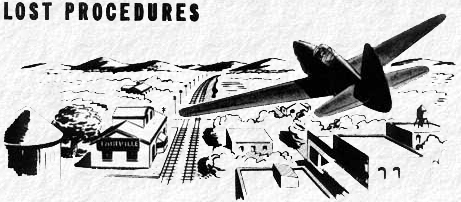 |
||
|
1. For maximum economy reduce the manifold pressure to 26" Hg. and the rpm setting to 2190. 2. Come down to an altitude between 1000 and 500 feet and look around for towns and landmarks which you might identify on your map. You can usually find the name of a town painted on a water tower, standpipe or railroad station. 3. Use your radio. If you have VHF, try to contact |
a station on the B channel and request an emergency homing. If you can't get any response on your VHF, turn on your Detrola. You can't transmit on the Detrola, but you can receive control towers and radio beams. Tune in on the strongest beam signal you can find, and follow it in for - a landing. If you have. an SCR 274 set, tune it to a beam and follow it in. 4. If you see an airfield, try to contact the tower with your radio. (If you have VHF, use the B channel.) If you fail to establish radio contact, come in and land. |
|
|
Technical Order Series 30-100 is the bible of instrument flying. You have it. Use it. Proficiency in instrument flying is life insurance. Wherever you are, whatever type airplane you are flying, you may have to use instruments. Never get out of practice. Here are a few tips that should help you if you get caught in bad weather and have to fly instruments: 1. Your instruments work better at slower speeds. Slow your airplane and lower 1/4 flaps. 2. Increase your rpm setting to 2600. |
3. If you want to climb, climb at a speed of about 160 mph 4. Make up your mind about how you are going to try to get out of the weather. Will you turn around, climb above or let down? When you have made a decision, stick to it. Don't change suddenly from a climb to a let-down, or vice versa. A panicky maneuver gets you into plenty of trouble. 5. Here are your beat indicated airspeeds:
|
|


